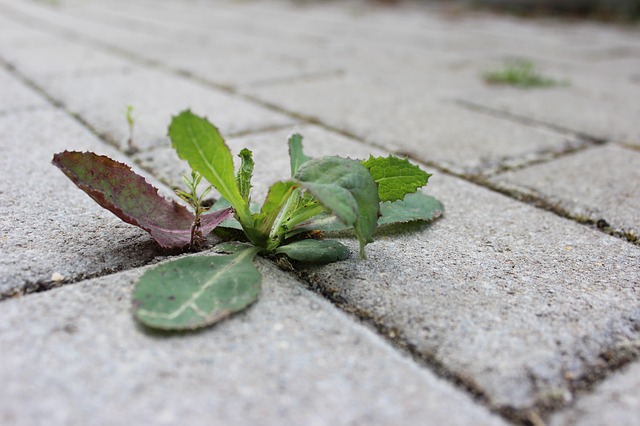
Weeds are one of the most frustrating outdoor nuisances for homeowners. Whether they’re sprouting between sidewalk cracks, patio pavers, or driveway joints, these unwanted invaders not only look messy but can also cause long-term damage. This leads many to ask: Can pressure washing help prevent weed growth in cracks?
The short answer is: Yes—when done correctly, pressure washing can be an effective tool to remove and slow the return of weeds in cracks. However, it’s not a magic cure-all. In this article, we’ll break down exactly how pressure washing works for weed control, what results you can expect, and additional steps you can take to keep those cracks weed-free for longer. 🌿💦
🌱 Why Do Weeds Grow in Cracks?
Cracks between concrete slabs, bricks, or pavers are ideal breeding grounds for weeds due to a combination of:
- Moisture retention: Water gets trapped in the cracks, especially in shaded areas.
- Soil accumulation: Over time, wind and rain deposit dust and organic debris into the gaps.
- Sun exposure: The warmth helps dormant seeds sprout quickly.
- Lack of maintenance: When not regularly cleaned, cracks become mini gardens for invasive plants.
Weeds like crabgrass, dandelions, moss, and even small trees can establish roots in these cracks if left unchecked. Over time, they can expand the cracks and damage your surfaces. 🧱
💦 How Pressure Washing Removes Weeds from Cracks
A pressure washer uses high-powered water jets to blast away dirt, debris, and plant matter from tight crevices. Here’s what it can do for weed removal:
✅ Uproot shallow-rooted weeds from concrete or paver joints
✅ Remove soil and organic debris that support new growth
✅ Dislodge moss, algae, and mold that thrive in damp areas
✅ Flush out seeds and spores before they germinate
With the right nozzle and technique, you can strip away both the visible weed and the dirt that supports its regrowth.
However, pressure washing alone may not kill the roots, especially for deep-rooted weeds. That’s where follow-up steps come in. 👇
🔧 Best Practices for Pressure Washing Weedy Cracks
To get the most out of your pressure washing efforts, follow these tips:
🔹 Use the Right Nozzle
- A narrow nozzle (15° or 25°) is ideal for targeting cracks.
- A turbo or rotary nozzle works well for wide areas with lots of joints.
🔹 Set the Right PSI
- For concrete or brick, 2,000–3,000 PSI is effective.
- For pavers or mortar-sensitive surfaces, stay closer to 1,500–2,000 PSI.
🔹 Move Slowly and Evenly
- Hold the wand at a 45° angle for deeper penetration.
- Move slowly along the cracks to dislodge roots and debris.
🔹 Rinse Thoroughly
- After removing the weeds, rinse the area well to remove leftover soil and plant fragments.
This method not only improves your curb appeal but helps minimize conditions that encourage weed regrowth.
Browse Amazon Here For Top Rated Power Washers And Accessories
⚠️ What Pressure Washing Doesn’t Do
As effective as pressure washing can be, it’s important to understand its limitations:
❌ It doesn’t kill deep roots: Stubborn weeds like dandelions may grow back unless roots are completely removed.
❌ It won’t prevent regrowth on its own: You’ll need to take follow-up steps.
❌ It can remove joint sand or filler between pavers, which you’ll need to replace.
❌ It may damage soft or cracked surfaces if too much pressure is used.
So while power washing is a strong first step, think of it as part of a broader weed control strategy.
🧪 Optional Step: Use a Natural or Commercial Weed Killer
After pressure washing, apply a weed treatment to help stop regrowth. You can go with:
✅ Natural Options:
- White vinegar + dish soap + salt: A popular DIY combo for killing remaining roots.
- Boiling water: Effective on small patches but requires care.
✅ Commercial Herbicides:
- Choose crack-safe formulas or post-emergent sprays.
- Look for glyphosate-free options if you’re concerned about pets or the environment.
Timing is key—apply these solutions right after pressure washing while cracks are still exposed.
🧱 Refill Cracks to Prevent Regrowth
Once everything is clean and dry, refill cracks to make it harder for weeds to come back. Here’s how:
For Paver Joints:
- Use polymeric sand, which hardens when wet and prevents seed germination.
- Sweep it into the joints and activate with a light mist of water.
For Concrete/Sidewalk Cracks:
- Use concrete crack filler or sealant to close gaps and discourage weeds.
This sealing step creates a physical barrier, reducing future weed invasion and prolonging the clean look of your surface.
🔁 How Often Should I Pressure Wash for Weed Control?
The frequency depends on your environment and how fast weeds tend to return:
| Area Type | Suggested Frequency |
|---|---|
| Driveways & Sidewalks | 1–2 times per year |
| Paver Patios | Every 6–12 months |
| Shady/Moist Areas | Every 3–6 months |
🌦️ Tip: After the rainy season is a great time to pressure wash, as this is when weeds tend to thrive.
✅ Final Verdict
So, does pressure washing help prevent weed growth in cracks?
Yes—when used correctly, it’s an excellent way to:
- Remove existing weeds and debris
- Dislodge soil and moisture that fuel regrowth
- Prepare surfaces for sealing or weed treatments
- Improve aesthetics and extend surface life
That said, pressure washing alone is not a permanent fix. For lasting results, follow up with weed treatments and fill the cracks with sand or sealant.
Your patio, driveway, or walkway doesn’t have to be overrun with weeds. With regular maintenance and a smart power washing routine, you can keep those cracks clean, sealed, and weed-free. 🌿🧼🚫
Browse Amazon Here For Top Rated Power Washers And Accessories






